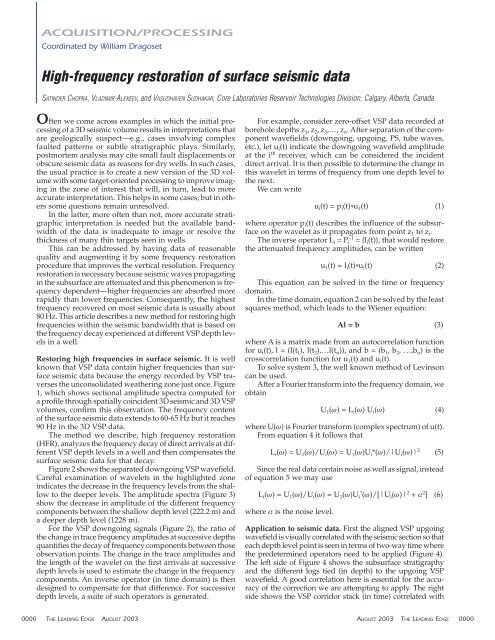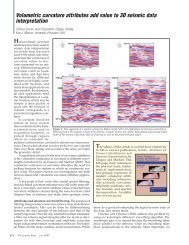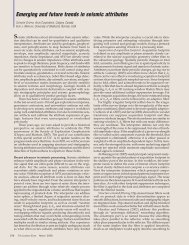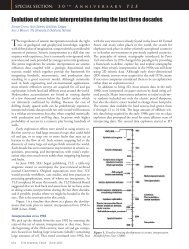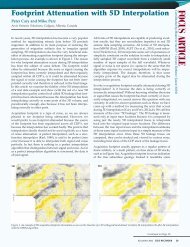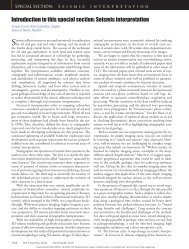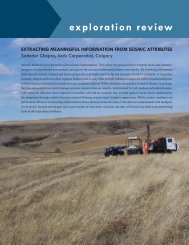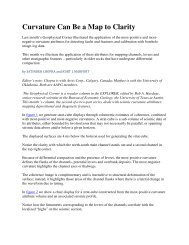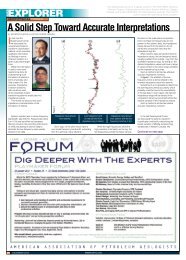High-frequency restoration of surface seismic data - Arcis
High-frequency restoration of surface seismic data - Arcis
High-frequency restoration of surface seismic data - Arcis
- No tags were found...
Create successful ePaper yourself
Turn your PDF publications into a flip-book with our unique Google optimized e-Paper software.
ACQUISITION/PROCESSINGCoordinated by William Dragoset<strong>High</strong>-<strong>frequency</strong> <strong>restoration</strong> <strong>of</strong> <strong>surface</strong> <strong>seismic</strong> <strong>data</strong>SATINDER CHOPRA, VLADIMIR ALEXEEV, and VASUDHAVEN SUDHAKAR, Core Laboratories Reservoir Technologies Division, Calgary, Alberta, CanadaOften we come across examples in which the initial processing<strong>of</strong> a 3D <strong>seismic</strong> volume results in interpretations thatare geologically suspect—e.g., cases involving complexfaulted patterns or subtle stratigraphic plays. Similarly,postmortem analysis may cite small fault displacements orobscure <strong>seismic</strong> <strong>data</strong> as reasons for dry wells. In such cases,the usual practice is to create a new version <strong>of</strong> the 3D volumewith some target-oriented processing to improve imagingin the zone <strong>of</strong> interest that will, in turn, lead to moreaccurate interpretation. This helps in some cases, but in otherssome questions remain unresolved.In the latter, more <strong>of</strong>ten than not, more accurate stratigraphicinterpretation is needed but the available bandwidth<strong>of</strong> the <strong>data</strong> is inadequate to image or resolve thethickness <strong>of</strong> many thin targets seen in wells.This can be addressed by having <strong>data</strong> <strong>of</strong> reasonablequality and augmenting it by some <strong>frequency</strong> <strong>restoration</strong>procedure that improves the vertical resolution. Frequency<strong>restoration</strong> is necessary because <strong>seismic</strong> waves propagatingin the sub<strong>surface</strong> are attenuated and this phenomenon is <strong>frequency</strong>dependent—higher frequencies are absorbed morerapidly than lower frequencies. Consequently, the highest<strong>frequency</strong> recovered on most <strong>seismic</strong> <strong>data</strong> is usually about80 Hz. This article describes a new method for restoring highfrequencies within the <strong>seismic</strong> bandwidth that is based onthe <strong>frequency</strong> decay experienced at different VSP depth levelsin a well.Restoring high frequencies in <strong>surface</strong> <strong>seismic</strong>. It is wellknown that VSP <strong>data</strong> contain higher frequencies than <strong>surface</strong><strong>seismic</strong> <strong>data</strong> because the energy recorded by VSP traversesthe unconsolidated weathering zone just once. Figure1, which shows sectional amplitude spectra computed fora pr<strong>of</strong>ile through spatially coincident 3D <strong>seismic</strong> and 3D VSPvolumes, confirm this observation. The <strong>frequency</strong> content<strong>of</strong> the <strong>surface</strong> <strong>seismic</strong> <strong>data</strong> extends to 60-65 Hz but it reaches90 Hz in the 3D VSP <strong>data</strong>.The method we describe, high <strong>frequency</strong> <strong>restoration</strong>(HFR), analyzes the <strong>frequency</strong> decay <strong>of</strong> direct arrivals at differentVSP depth levels in a well and then compensates the<strong>surface</strong> <strong>seismic</strong> <strong>data</strong> for that decay.Figure 2 shows the separated downgoing VSP wavefield.Careful examination <strong>of</strong> wavelets in the highlighted zoneindicates the decrease in the <strong>frequency</strong> levels from the shallowto the deeper levels. The amplitude spectra (Figure 3)show the decrease in amplitude <strong>of</strong> the different <strong>frequency</strong>components between the shallow depth level (222.2 m) anda deeper depth level (1228 m).For the VSP downgoing signals (Figure 2), the ratio <strong>of</strong>the change in trace <strong>frequency</strong> amplitudes at successive depthsquantifies the decay <strong>of</strong> <strong>frequency</strong> components between thoseobservation points. The change in the trace amplitudes andthe length <strong>of</strong> the wavelet on the first arrivals at successivedepth levels is used to estimate the change in the <strong>frequency</strong>components. An inverse operator (in time domain) is thendesigned to compensate for that difference. For successivedepth levels, a suite <strong>of</strong> such operators is generated.For example, consider zero-<strong>of</strong>fset VSP <strong>data</strong> recorded atborehole depths z 1 , z 2 , z 3 ,…, z n . After separation <strong>of</strong> the componentwavefields (downgoing, upgoing, PS, tube waves,etc.), let u i (t) indicate the downgoing wavefield amplitudeat the i th receiver, which can be considered the incidentdirect arrival. It is then possible to determine the change inthis wavelet in terms <strong>of</strong> <strong>frequency</strong> from one depth level tothe next.We can writeu i (t) = p i (t)*u 1 (t) (1)where operator p i (t) describes the influence <strong>of</strong> the sub<strong>surface</strong>on the wavelet as it propagates from point z 1 to z i .The inverse operator L i = P i-1= {l i (t)}, that would restorethe attenuated <strong>frequency</strong> amplitudes, can be writtenu 1 (t) = l i (t)*u i (t) (2)This equation can be solved in the time or <strong>frequency</strong>domain.In the time domain, equation 2 can be solved by the leastsquares method, which leads to the Wiener equation:Al = b (3)where A is a matrix made from an autocorrelation functionfor u i (t), l = (l(t 1 ), l(t 2 ),…l(t n )), and b = (b 1 , b 2 , …,b n ) is thecrosscorrelation function for u 1 (t) and u i (t).To solve system 3, the well known method <strong>of</strong> Levinsoncan be used.After a Fourier transform into the <strong>frequency</strong> domain, weobtainU 1 (ω) = L i (ω) U i (ω) (4)where U(ω) is Fourier transform (complex spectrum) <strong>of</strong> u(t).From equation 4 it follows thatL i (ω) = U 1 (ω)/U i (ω) = U 1 (ω)U i *(ω)/|U i (ω)| 2 (5)Since the real <strong>data</strong> contain noise as well as signal, instead<strong>of</strong> equation 5 we may useL i (ω) = U 1 (ω)/U i (ω) = U 1 (ω)U i* (ω)/[|U i (ω)| 2 + α 2 ] (6)where α is the noise level.Application to <strong>seismic</strong> <strong>data</strong>. First the aligned VSP upgoingwavefield is visually correlated with the <strong>seismic</strong> section so thateach depth level point is seen in terms <strong>of</strong> two-way time wherethe predetermined operators need to be applied (Figure 4).The left side <strong>of</strong> Figure 4 shows the sub<strong>surface</strong> stratigraphyand the different logs tied (in depth) to the upgoing VSPwavefield. A good correlation here is essential for the accuracy<strong>of</strong> the correction we are attempting to apply. The rightside shows the VSP corridor stack (in time) correlated with0000 THE LEADING EDGE AUGUST 2003 AUGUST 2003 THE LEADING EDGE 0000
Figure 1.Sectional amplitudespectra <strong>of</strong> apr<strong>of</strong>ile from <strong>surface</strong><strong>seismic</strong> (left),and 3D VSP(right). Verticalaxis is <strong>frequency</strong>.Figure 2.Downgoingwavefieldobtained afterseparation <strong>of</strong>componentwavefields fromthe VSP totalwavefield forwell 1.Figure 3.Amplitude spectraat a shallowand a deep depthlevel.0000 THE LEADING EDGE AUGUST 2003 AUGUST 2003 THE LEADING EDGE 0000
Figure 4. Correlation <strong>of</strong> stratigraphy, VSP upgoing wavefield, well logs, VSP corridor stack, and <strong>surface</strong> <strong>seismic</strong> <strong>data</strong>.Figure 5. Seismic inline 85 extracted out <strong>of</strong> a 3D <strong>seismic</strong> volume before (left) and after (right) HFR.logs, a filtered version <strong>of</strong> the corridor stack, and the <strong>seismic</strong>section. The green lines indicate the depth-to-time matching<strong>of</strong> individual formation tops seen on the logs and upgoingwavefield (in depth) with the <strong>surface</strong> <strong>seismic</strong> <strong>data</strong>. This fixesthe VSP upgoing wavefield extent or spread on the <strong>seismic</strong>.The first operator corresponding to the first depth level is nowassigned a starting time and so, in this way, each determinedoperator has a corresponding time node point application onthe <strong>seismic</strong>. Thereafter, the filter application is run (as convolutionin time domain) on the <strong>seismic</strong> <strong>data</strong>. As operators areapplied continuously to the stacked <strong>data</strong>, windowing isavoided. Application <strong>of</strong> these inverse operators on <strong>surface</strong> <strong>seismic</strong><strong>data</strong> enhance the <strong>frequency</strong> bandwidth by restoring theattenuated <strong>frequency</strong> components.0000 THE LEADING EDGE AUGUST 2003 AUGUST 2003 THE LEADING EDGE 0000
Figure 6. Sectional amplitude spectra for <strong>seismic</strong> inline 85 indicates the extent <strong>of</strong> <strong>frequency</strong> enhancement.Figure 7. Seismic crossline 72 before (left) and after (right) HFR.A3D VSP and a coincident 3D <strong>surface</strong> <strong>seismic</strong> surveywere recorded around well 8-20 in the Hanna area <strong>of</strong> centralAlberta, targeting the Lower Mannville formation (Chopra etal., 2002). The well encountered a gross Lower Mannvilleinterval 20.5 m thick and thicker than in adjacent wells 6-20(11.5 m) and 8-21 (7 m). The 3D <strong>seismic</strong> programs (<strong>surface</strong> andVSP) were recorded to assist in defining sand presence andporosity development in the Lower Mannville intervalbetween 1300 and 1350 m. The objectives for the 3D VSPrecording were to (a) tie the <strong>seismic</strong> reflections to lithologyand stratigraphic boundaries; (b) obtain a high <strong>frequency</strong>image around the borehole (the fixed receiver array and itsproximity to the reservoir are expected to improve imagequality); and (c) obtain an improved sub<strong>surface</strong> velocity model.HFR was run on the <strong>seismic</strong> <strong>data</strong>. Figure 5 shows a segment<strong>of</strong> <strong>seismic</strong> inline 85 with and without HFR. Notice the0000 THE LEADING EDGE AUGUST 2003 AUGUST 2003 THE LEADING EDGE 0000
Figure 8. Sectional amplitude spectra for <strong>seismic</strong> crossline 72 before (left) and after (right) HFR.Figure 9. Overlay <strong>of</strong> a 3D VSP vertical plane and <strong>seismic</strong> (inline 85) after HFR.0000 THE LEADING EDGE AUGUST 2003 AUGUST 2003 THE LEADING EDGE 0000
Figure 11. Timeslices from thecoherence volumesbefore (left) andafter (right) HFR.Figure 12. Timeslices from thecoherence volumesbefore (left) andafter (right) HFR.Figure 13. (a)Segment <strong>of</strong> impedancesection.<strong>High</strong>lighted portionindicateslower impedanceat the level <strong>of</strong> gassand but does notdistinguish it. (b)Segment <strong>of</strong> impedancesection.<strong>High</strong>lighted portionindicates theextent <strong>of</strong> the gassand clearly.a)b)0000 THE LEADING EDGE AUGUST 2003 AUGUST 2003 THE LEADING EDGE 0000
a)Figure 14. (a) Operators derived from well 1.(b) Operators derived from well 2. (c)Difference <strong>of</strong> operators derived from wells 1and 2.b)c)For the same area, if the geology does not change abruptly,the HFR filters from different VSP surveys should be the same,(assuming <strong>data</strong> quality is good and is acquired using similarequipment). The set <strong>of</strong> inverse filters were computed fromVSPs in two different wells in the same field. The objectivewas to determine how different these sets <strong>of</strong> filters were.Figures 14a and 14b show the filters determined from two differentwells. Figure 14c shows their difference. Clearly, the filtersare almost identical. Such tests carried out on differentwells in different areas lead us to conclude that HFR is robust.However, in areas where geology changes fast laterally, a spatialadaptive filter application approach may be necessary.Prestack application <strong>of</strong> HFR. Application <strong>of</strong> HFR to poststack<strong>data</strong> has been illustrated in the examples above. Applicationto prestack <strong>data</strong> is also very effective and useful for AVOanalysis. However, since a zero-<strong>of</strong>fset VSP is used to determinethe attenuation in terms <strong>of</strong> a set <strong>of</strong> HFR filters, applicationto <strong>seismic</strong> gathers would mean application <strong>of</strong> the sameset <strong>of</strong> filters for all <strong>of</strong>fset traces. Attempts at <strong>of</strong>fset-dependentcorrection to gathers requires several walkaway VSPs fordetermining one set <strong>of</strong> HFR filters for each <strong>of</strong>fset. This exercisehas been carried out with convincing results for AVOanalysis. This work is currently under way and will be presentedupon its completion.Conclusions. The HFR method described in this article differsfrom conventional industry methods. It consists <strong>of</strong> determiningthe <strong>frequency</strong>-dependent decay from downgoing VSPfirst arrivals from successive depth levels, and then applyingthe inverse decay function to <strong>surface</strong> <strong>seismic</strong> <strong>data</strong>. Advantages<strong>of</strong> this procedure include:• poor reflection zones, resulting from strong impedancecontrasts above and below a particular zone <strong>of</strong> interest,show greater reflection detail and continuity and bettermatch corridor stacks or VSP <strong>of</strong>fset sections• impedance inversion on <strong>data</strong> with HFR application, andhence higher bandwidth, show more detail and lead tomore detailed interpretation <strong>of</strong> important stratigraphicfeatures,• HFR methodology is robust.HFR helps define trends better and leads to more confidentinterpretations. Such applications could redefineprospects, which in some cases may have been declaredunsuccessful, when the interpretations are based on <strong>seismic</strong><strong>data</strong> with poor bandwidth.Suggested reading. “Simultaneous acquisition <strong>of</strong> 3D <strong>surface</strong><strong>seismic</strong> and 3D VSP <strong>data</strong>—processing and integration” byChopra et al. (SEG 2002 Expanded Abstracts). “Fault interpretation—thecoherence cube and beyond” by Chopra and Sudhakar(Oil and Gas Journal, 2000). “Azimuth based coherence for detectingfaults and fractures” by Chopra et al. (World Oil, 2000).“Model-based Q compensation” by Hirsche et al. (SEG 1984Expanded Abstracts). TLEAcknowledgments: Coherence Cube and HFR are trademarks <strong>of</strong> CoreLaboratories. We are indebted to Bob Hardage and Rob Stewart for editingthe manuscript thoroughly and improving its quality. We thank JoanneLanteigne for formatting some images in this paper and Jan Dewar for hervaluable comments and suggestions. We thank ConocoPhillips Canada forrelease <strong>of</strong> <strong>data</strong> and Core Laboratories for permission to publish.Corresponding author: schopra@corelab.ca0000 THE LEADING EDGE AUGUST 2003 AUGUST 2003 THE LEADING EDGE 0000


